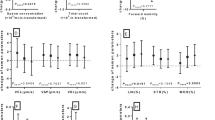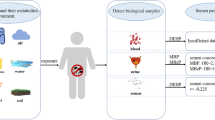Abstract
Purpose
To measure the concentrations of urinary di(2-ethylhexyl) phthalate (DEHP) metabolites in polyvinyl chloride (PVC) workers and a control group for determining the relationship of DEHP exposure to semen quality, sperm reactive oxygen species (ROS) generation, and sperm apoptosis.
Methods
We assessed the metabolites of DEHP, namely urinary mono-(2-ethylhexyl) phthalate (MEHP), mono-(2-ethyl-5-hydroxyhexyl) phthalate (MEHHP), and mono-(2-ethyl-5-oxohexyl) phthalate (MEOHP), and semen quality, such as sperm concentration, motility, morphology, ROS generation, and DNA damage by using terminal deoxynucleotidyl transferase-mediated nick end labeling assay obtained from 47 workers employed within two PVC pellet plants and 15 graduate students in Taiwan.
Results
Sperm concentration and motility were significantly affected in the high-exposure group. The percentage and intensity of sperm ROS generation were higher in the high-exposure group than those in the control group. After adjustment for age, smoking status, and coffee consumption, the decrease in sperm motility was inversely associated with the concentration of MEHP (β = −0.549, p = 0.0085), MEHHP (β = −0.155, p = 0.0074), and MEOHP (β = −0.201, p = 0.0041). Moreover, sperm apoptosis and ROS generation were positively associated with MEHHP and MEOHP concentration, respectively.
Conclusions
This was the first study to explore the associations between levels of DEHP exposure, sperm motility, ROS generation, and apoptosis. The results suggested that urinary MEHHP and MEOHP were sensitive biomarkers for reflecting the relationship between DEHP exposure and semen quality.

Similar content being viewed by others
Abbreviations
- BMI:
-
Body mass index
- CI:
-
Confidence interval
- DCHF-DA:
-
Dichlorofluorescin diacetate
- DEHP:
-
Di(2-ethylhexyl) phthalate
- GM:
-
Geometric mean
- GSD:
-
Geometric standard deviation
- HE:
-
Hydroethidine
- MEHP:
-
Mono-(2-ethylhexyl) phthalate
- MEHHP:
-
Mono-(2-ethyl-5-hydroxyhexyl) phthalate
- MEOHP:
-
Mono-(2-ethyl-5-oxohexyl) phthalate
- NADPH:
-
Nicotinamide adenine dinucleotide phosphate
- PI:
-
Propidium iodide
- PVC:
-
Polyvinyl chloride
- QC:
-
Quality control
- ROS:
-
Reactive oxygen species
- SCSA:
-
Sperm chromatin DNA structure assay
- SD:
-
Standard deviation
- TUNEL:
-
Terminal deoxynucleotidyl transferase-mediated nick end labeling
References
Agarwal A, Saleh RA, Bedaiwy MA (2003) Role of reactive oxygen species in the pathophysiology of human reproduction. Fertil Steril 79:829–843
Aitken RJ, De Iuliis GN (2010) On the possible origins of DNA damage in human spermatozoa. Mol Hum Reprod 16:3–13
Aitken RJ, De Iuliis GN, Jane M (2010) Analysis of the relationships between oxidative stress, DNA damage and sperm vitality in a patient population: development of diagnostic criteria. Hum Reprod 25:2415–2426
Aitken RJ, Whiting S, De Iuliis GN et al (2012) Electrophilic aldehydes generated by sperm metabolism activate mitochondrial reactive oxygen species generation and apoptosis by targeting succinate dehydrogenase. J Biol Chem 287:33048–33060
Bakuradze T, Boehm N, Janzowski C et al (2011) Antioxidant-rich coffee reduces DNA damage, elevates glutathione status and contributes to weight control: results from an intervention study. Mol Nutr Food Res 55:793–797
Barr DB, Wilder LC, Caudill SP et al (2005) Urinary creatinine concentrations in the U.S. population: implications for urinary biologic monitoring measurements. Environ Health Perspect 113:192–200
Belcheva A, Ivanova-Kicheva M, Tzvetkova P et al (2004) Effects of cigarette smoking on sperm plasma membrane integrity and DNA fragmentation. Int J Androl 27(5):296–300
Benchaib M, Braun V, Lornage J (2003) Sperm DNA fragmentation decreases the pregnancy rate in an assisted reproductive technique. Hum Reprod 18:1023–1028
Bichler J, Cavin C, Simic T et al (2007) Coffee consumption protects human lymphocytes against oxidative and 3-amino-1-methyl-5H-pyrido[4,3-b]indole acetate (Trp-P-2) induced DNA-damage: results of an experimental study with human volunteers. Food Chem Toxicol 45:1428–1436
Boffetta P, Hashibe M (2006) Alcohol and cancer. Lancet Oncol 7:149–156
Bréchard S, Melchior C, Plancon S et al (2008) Store-operated Ca2+ channels formed by TRPC1, TRPC6 and Orai1 and non-store-operated channels formed by TRPC3 are involved in the regulation of NADPH oxidase in HL-60 granulocytes. Cell Calcium 44:492–506
Caldwell JC (2012) DEHP: genotoxicity and potential carcinogenic mechanisms—a review. Mutat Res 751:82–157
Centers for Disease Control and Prevention (CDC) (2005) Third national report on human exposure to environmental chemicals. United States. Available at: http://www.cdc.gov/exposurereport/
Clark K, Cousins I, MacKay D (2003) Assessment of critical exposure pathways. In: Staples CA (ed) The handbook of environmental chemistry, vol 3., Part Q: phthalate estersSpringer, New York, pp 227–262
Cohen-Bacrie P, Belloc S, Ménézo YJ et al (2009) Correlation between DNA damage and sperm parameters: a prospective study of 1,633 patients. Fertil Steril 91:1801–1805
Duty SM, Silva MJ, Barr DB et al (2003) Phthalate exposure and human semen parameters. Epidemiology 14:269–277
Erkekoglu P, Rachidi W, Yuzugullu OG et al (2010) Evaluation of cytotoxicity and oxidative DNA damaging effects of di(2-ethylhexyl)-phthalate (DEHP) and mono(2-ethylhexyl)-phthalate (MEHP) on MA-10 Leydig cells and protection by selenium. Toxicol Appl Pharmacol 248:52–62
Evenson DP, Larson KL, Jost LK (2002) Sperm chromatin structure assay: its clinical use for detecting sperm DNA fragmentation in male infertility and comparisons with other techniques. J Androl 23:25–43
Fisher MT, Nagarkatti M, Nagarkatti PS (2005) Aryl hydrocarbon receptor-dependent induction of loss of mitochondrial membrane potential in epididymal spermatozoa by 2,3,7,8-tetrachlorodibenzo-p-dioxin (TCDD). Toxicol Lett 157:99–107
Foster PM (2006) Disruption of reproductive development in male rat offspring following in utero exposure to phthalate esters. Int J Androl 29:140–147
Ge RS, Chen GR, Dong Q et al (2007) Biphasic effects of postnatal exposure to diethylhexylphthalate on the timing of puberty in male rats. J Androl 28:513–520
Gorczyca W, Traganos F, Jesionowska H et al (1993) Presence of DNA strand breaks and increased sensitivity of DNA in situ to denaturation in abnormal human sperm cells: analogy to apoptosis of somatic cells. Exp Cell Res 207:202–205
Hauser R, Meeker JD, Singh NP et al (2007) DNA damage in human sperm is related to urinary levels of phthalate monoester and oxidative metabolites. Hum Reprod 22:688–695
Herr C, zur Nieden A, Koch HM et al (2009) Urinary di(2-ethylhexyl)phthalate (DEHP)-metabolites and male human markers of reproductive function. Int J Hyg Environ Health 212:648–653
Hoffmann H, Högel J, Speit G (2005) The effect of smoking on DNA effects in the comet assay: a meta-analysis. Mutagenesis 20:455–466
Huang PC, Kuo PL, Guo YL (2007) Associations between urinary phthalate monoesters and thyroid hormones in pregnant women. Hum Reprod 22:2715–2722
Huang LP, Lee CC, Hsu PC et al (2011) The association between semen quality in workers and the concentration of di(2-ethylhexyl) phthalate in polyvinyl chloride pellet plant air. Fertil Steril 96:90–94
Jonsson BAG, Richthoff J, Rylander L et al (2005) Urinary phthalate metabolites and biomarkers of reproductive function in young men. Epidemiology 16:487–493
Kasahara E, Sato EF, Miyoshi M et al (2002) Role of oxidative stress in germ cell apoptosis induced by di(2-ethylhexyl) phthalate. Biochem J 365:849–856
Koch HM, Rossbach B, Drexler H et al (2003) Internal exposure of the general population to DEHP and other phthalates—determination of secondary and primary phthalate monoester metabolites in urine. Environ Res 93:177–185
Kodama H, Yamaguchi R, Fukuda J et al (1997) Increased deoxyribonucleic acid damage in the spermatozoa of infertile male patients. Fertil Steril 68:519–524
Liu L, Bao H, Liu F et al (2012) Phthalates exposure of Chinese reproductive age couples and its effect on male semen quality, a primary study. Eviron Int 42:78–83
Muratori M, Tamburrino L, Marchiani S (2010) Critical aspects of detection of sperm DNA fragmentation by TUNEL/flow cytometry. Syst Biol Reprod Med 56:277–285
Palleschi S, Rossi B, Diana L et al (2009) Di(2-ethylhexyl) phthalate stimulates Ca2+ entry, chemotaxis and ROS production in human granulocytes. Toxicol Lett 187:52–57
Pant N, Shukla M, Kumar Patel D et al (2008) Correlation of phthalate exposures with semen quality. Toxicol Appl Pharmacol 231:112–116
Schmid TE, Eskenazi B, Baumgartner A et al (2007) The effects of male age on sperm DNA damage in healthy non-smokers. Hum Reprod 22:180–187
Sharma RK, Sabanegh E, Mahfouz R et al (2010) TUNEL as a test for sperm DNA damage in the evaluation of male infertility. Urology 76:1380–1386
Silva MJ, Reidy JA, Preau JL Jr et al (2006) Oxidative metabolites of diisononyl phthalate as biomarkers for human exposure assessment. Environ Health Perspect 114:1158–1161
Stokes-Riner A, Thurston SW, Brazil C et al (2007) One semen sample or 2? Insights from a study of fertile men. J Androl 28:638–643
Toshima H, Suzuki Y, Imai K et al (2012) Endocrine disrupting chemicals in urine of Japanese male partners of subfertile couple: a pilot study on exposure and semen quality. Int J Hyg Environ Health 215:502–506
Wirth JJ, Rossano MG, Potter R et al (2008) A pilot study associating urinary concentrations of phthalate metabolites and semen quality. Syst Biol Reprod Med 54:143–154
World Health Organization (1999) WHO laboratory manual for the examination of human semen and sperm-cervical mucus interaction, 4th edn. Cambridge University Press, Cambridge
World Health Organization (2010) WHO laboratory manual for the examination and processing of human semen, 5th edn. WHO Press, Geneva
Acknowledgments
The authors acknowledge the financial support provided by the Institute of Occupational Safety and Health (IOSH98-M306) and the National Science Council (NSC 100-2314-B-327-001) of Taiwan.
Conflict of interest
The authors declare that they have no conflict interest.
Author information
Authors and Affiliations
Corresponding author
Additional information
Li-Ping Huang and Ching-Chang Lee have contributed equally to this work.
Rights and permissions
About this article
Cite this article
Huang, LP., Lee, CC., Fan, JP. et al. Urinary metabolites of di(2-ethylhexyl) phthalate relation to sperm motility, reactive oxygen species generation, and apoptosis in polyvinyl chloride workers. Int Arch Occup Environ Health 87, 635–646 (2014). https://doi.org/10.1007/s00420-013-0905-6
Received:
Accepted:
Published:
Issue Date:
DOI: https://doi.org/10.1007/s00420-013-0905-6




